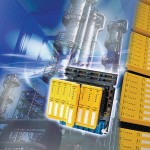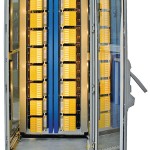Turck’s interface module backplane combines up to 32 I/O channels with electrical isolation and a redundant power supply in a minimum of space, thus creating more room in the control cabinet. Hart-compatible analogue cards and temperature measuring amplifiers that can be parameterised using DTMs round off the I/O solution, providing a seamless concept for the level between the field devices and the process control system.
The author: Klaus Ebinger Product manager for interface technology and fluid sensors, Turck
Turck’s interface module backplane (IMB) adds a robust and extremely compact I/O so-lution to what is already a comprehensive portfolio. With a footprint of only 175 x 210 mm, the backplane provides space for eight interface modules and thus up to 32 digital or 16 analogue inputs and outputs – as required by the customer. Depending on the application, users can implement control cabinets with a very high density of up to 1152 channels.
The module racks come with a host of smart features: with standardised analogue and digital system couplings for the Honeywell C300, Emerson DeltaV and Yokogawa Centum process control systems, a redundant power supply and a high temperature resistance, the IMBs establish a new level of flexibility in the control cabinet. Thanks to their low price per channel compared to DIN rail installations, the easy-to-handle IMB point-to-point solution is ideal both for fully expanded control cabinets with several hundred inputs and outputs and for less complex applications with only a few I/Os.
Minimum engineering expenditure
The main benefit of the station is that because the backplane unites the complete connection level and the electrical isolation of the I/O channels can be realised simply by inserting the interface cards, the engineering effort for the entire interface level is reduced enormously – both for maintenance and for sched-uled expansions. The easy-to-access screw or spring terminals, as well as the colour coded and physically separate system connections, effectively prevent connection errors. Added to this is the convenient “hot swap” functionality.
The pin assignment of the system connections is adapted directly to the relevant process control system, so that special connection mod-ules are no longer required and inexpensive, prefabricated 1:1 cables that are readily available can be used instead – a considerable benefit in terms of electronic component supplies, not to mention the installation and mainte-nance costs for the interface level.
Safety on board
The backplane is the jumpering level for the complete I/O solution and is a one hundred percent passive component. Unlike similar systems, there is no active component on the hardware that could paralyse the entire isolation level in the event of a failure. As each interface card is also protected individually, the availability of the isolation level is ensured even if single channels fail. Furthermore, Turck’s IMB offers a simple redundancy concept for the connection level to the control system. Whereas conventional, point-to-point wiring only allowed broken connections to be compensated for by doubling the input signals, the redundant terminals for the I/O cards of the process control systems allow separate safety concepts to be implemented for the electronics and wiring.
The energy balance of a plant is becoming an increasingly important factor for operators in addition to the availability of the interface level and consequently that of the plant as a whole. The efficiency of a process ultimately depends on the total cost of ownership, in which the energy requirement of loop powered 4 to 20 mA transmitters can play a significant part. Here, developers at Turck have been able to cut the energy consumption of the isolating transducers (AIA) without any reduction in power. The loop powered analogue input/output cards are also highly energy efficient.
Transparency down to the field level
Both dual-channel analogue input/output interface cards and the available isolating transducers are Hart-compatible. A Hart signal modulated on the analogue signal enables additional information from the field device level to be accessed directly. Using special device drivers, so-called DTMs, the installed temperature measuring amplifiers and the field instrumentation can be parameterised below the isolation level with a single, non-proprietary engineering tool such as the free Pactware configuration software. The parameterisation tool permits easy and user-friendly management of the DTMs with just a few clicks of the mouse, regardless of the bus protocol, feature visualisation or settings and parameterisation of the connected devices.
The interface cards moreover provide diagnostic LEDs for indicating all relevant operating states. Up to four dual-coloured LEDs (digital input/output cards) show the switching states of the monitored outputs in yellow. When input circuit monitoring is activated, the LEDs change to red if a fault occurs in the input circuit and the corresponding output and alarm relays are switched. In other words, the interface cards allow the I/O level functions to be monitored directly at the devices in the control cabinet.
Just like the DIN rail interface devices, the IMB interface cards also convince with a high temperature specification. With an operating temperature range from -20 to +70 °C, backplanes fitted with these cards are suitable for installation in non-climate-controlled cabinets or in the top part of cabinets where there is more exposure to warm air from fans. The design of the passive backplane ensures efficient heat dissipation.
cpp-net.com/0312426
Share:








